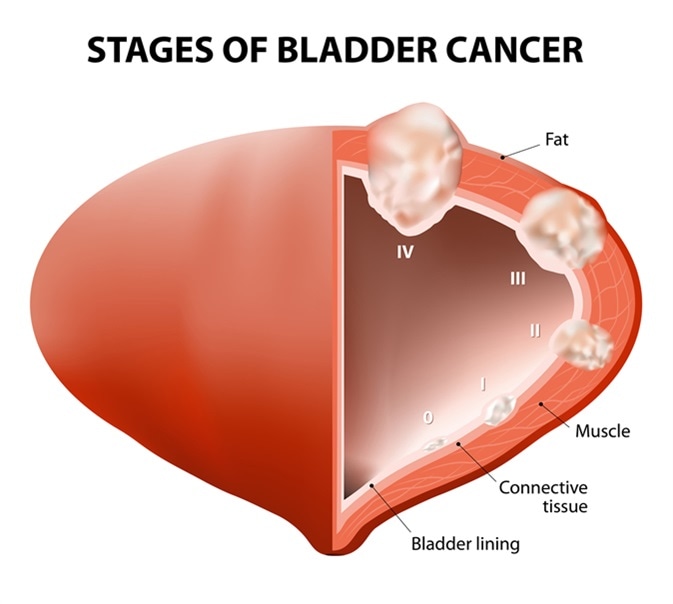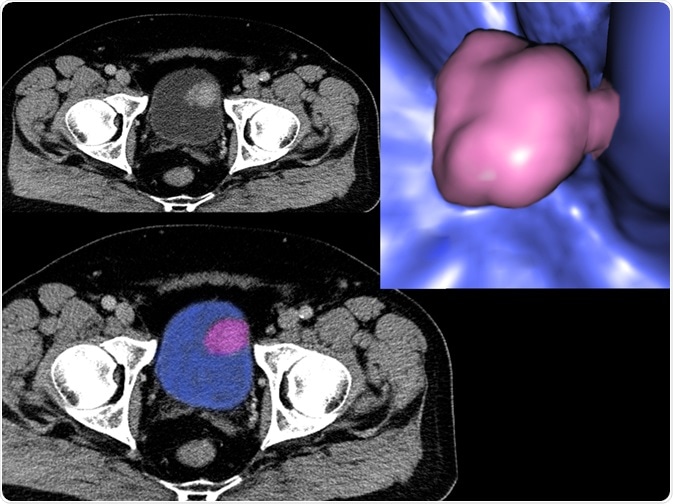There are many techniques that are used to diagnose and monitor bladder cancer; however, the most common are highly invasive. These techniques cause anxiety for the patient and can impact how early the cancer can be detected. Since early diagnosis is key for boosting patient prognosis, several non-invasive techniques have been suggested as possible alternatives to these traditional methods.

Image Credit: Designua / Shutterstock
Invasive techniques
One example of an invasive diagnostic tool is cystoscopy. This is a very uncomfortable procedure, in which a thin camera within a tube is inserted through the urethra to allow the doctor to observe the bladder and detect the presence of any abnormal growths.
Upon the detection of a tumor through this method, a biopsy is often carried out, in which the tumor and surrounding tissue are removed and analyzed. This can indicate both the staging of the cancer, which is dependent upon their differentiation, as well as the invasiveness of the tumor, which is dependent upon the level of invasion into the surrounding tissue.
Overall, these methods are accurate and can inform doctors about numerous key qualities; however, they are also very invasive and can cause significant psychological stress to the patient.
Diagnosing and Treating Bladder Cancer
Imaging techniques
Rather than viewing the tumor from inside the body or removing it, there are several less-invasive techniques that can allow for visualization of the tumor from outside the body. These methods use either sound waves, X-rays, or magnetic fields to create highly accurate and detailed images of internal structures that can be used to identify growth abnormalities.
Firstly, a computed tomography (CT) scan can be carried out, which forms a three-dimensional (3D) image of the internal organs of the body using X-rays. More specifically, a CT scan involving the bladder is called a CT urogram. This technique can be used to detect changes in tissue structure and nearby lymph nodes, thus indicating the size and position of the tumor, as well as the stage of the cancer.
Another non-invasive cancer imaging technique is magnetic resonance imaging (MRI). Rather than utilizing X-rays to obtain images, magnetic fields are used to form images of internal structures and identify tumors.

Image Credit: Semnic / Shutterstock.com
Other imaging techniques are also often used to indicate if the bladder cancer has spread or not. These include chest X-rays, which can show if the cancer has spread to the lungs. Additionally, bone scans accompanied by radioactive labeling can be used to show if cancer has spread it the bone.
Overall, imaging techniques are important methods in bladder cancer diagnosis, as they provide an alternative to invasive cystoscopies and biopsies.
Urinalysis techniques
Another non-invasive technique for detecting bladder cancer is through the analysis of urine samples. These samples can undergo numerous tests to detect possible tumors and monitor treatments. Initially, urine samples can be analyzed under a microscope through a technique called urinary cytology that allows the clinician to look for the presence of cancerous cells. However, this test is not as accurate as compared to other methods.
To enhance accuracy, urinary samples can also be tested for the presence of cancer-related biomarkers. These are molecules that are either formed by the cancer or due to the presence of cancer. Therefore, the detection of these markers within the urine can indicate the presence of a tumor inside the bladder.
For example, NMP22 and human complement factor H proteins are present at much higher levels in cancer patients as compared to healthy patients. Therefore, highly specific and sensitive tests have been designed to detect these proteins at low levels. Additionally, mutations in DNA can also be detected, such as a point mutation in the fibroblast growth factor receptor 3, which is found in approximately 50% of bladder cancer patients.
Overall, there are many different testing options available to assist in the diagnosis of bladder cancer. The standard procedure for tumor detection is through invasive techniques like cystoscopy and biopsies. However, these alternate methods also enable the detection of cancers without the associated psychological anxiety and discomfort.
There are also many more biomarkers that are currently under investigation for applications within bladder cancer diagnosis. Confirming the significance of these biomarkers in bladder cancer may further enhance the effectiveness of non-invasive urinalysis.
References
Further Reading